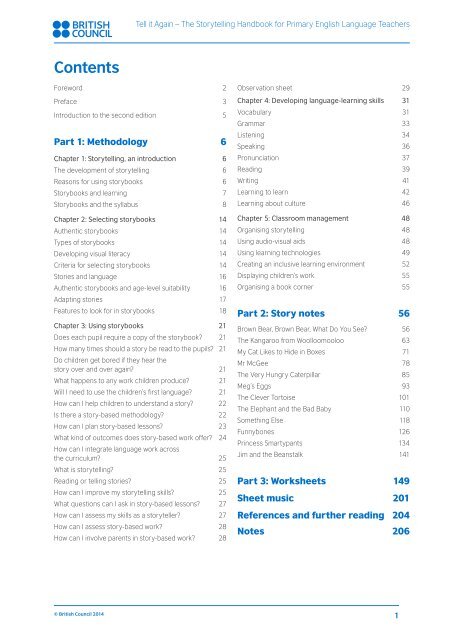1nW0gvB
1nW0gvB
1nW0gvB
Create successful ePaper yourself
Turn your PDF publications into a flip-book with our unique Google optimized e-Paper software.
Tell it Again – The Storytelling Handbook for Primary English Language Teachers<br />
Contents<br />
Foreword2<br />
Preface3<br />
Introduction to the second edition 5<br />
Part 1: Methodology 6<br />
Chapter 1: Storytelling, an introduction 6<br />
The development of storytelling 6<br />
Reasons for using storybooks 6<br />
Storybooks and learning 7<br />
Storybooks and the syllabus 8<br />
Chapter 2: Selecting storybooks 14<br />
Authentic storybooks 14<br />
Types of storybooks 14<br />
Developing visual literacy 14<br />
Criteria for selecting storybooks 14<br />
Stories and language 16<br />
Authentic storybooks and age-level suitability 16<br />
Adapting stories 17<br />
Features to look for in storybooks 18<br />
Chapter 3: Using storybooks 21<br />
Does each pupil require a copy of the storybook? 21<br />
How many times should a story be read to the pupils? 21<br />
Do children get bored if they hear the<br />
story over and over again? 21<br />
What happens to any work children produce? 21<br />
Will I need to use the children’s first language? 21<br />
How can I help children to understand a story? 22<br />
Is there a story-based methodology? 22<br />
How can I plan story-based lessons? 23<br />
What kind of outcomes does story-based work offer? 24<br />
How can I integrate language work across<br />
the curriculum? 25<br />
What is storytelling? 25<br />
Reading or telling stories? 25<br />
How can I improve my storytelling skills? 25<br />
What questions can I ask in story-based lessons? 27<br />
How can I assess my skills as a storyteller? 27<br />
How can I assess story-based work? 28<br />
How can I involve parents in story-based work? 28<br />
Observation sheet 29<br />
Chapter 4: Developing language-learning skills 31<br />
Vocabulary31<br />
Grammar33<br />
Listening34<br />
Speaking36<br />
Pronunciation37<br />
Reading39<br />
Writing41<br />
Learning to learn 42<br />
Learning about culture 46<br />
Chapter 5: Classroom management 48<br />
Organising storytelling 48<br />
Using audio-visual aids 48<br />
Using learning technologies 49<br />
Creating an inclusive learning environment 52<br />
Displaying children’s work 55<br />
Organising a book corner 55<br />
Part 2: Story notes 56<br />
Brown Bear, Brown Bear, What Do You See? 56<br />
The Kangaroo from Woolloomooloo 63<br />
My Cat Likes to Hide in Boxes 71<br />
Mr McGee 78<br />
The Very Hungry Caterpillar 85<br />
Meg’s Eggs 93<br />
The Clever Tortoise 101<br />
The Elephant and the Bad Baby 110<br />
Something Else 118<br />
Funnybones126<br />
Princess Smartypants 134<br />
Jim and the Beanstalk 141<br />
Part 3: Worksheets 149<br />
Sheet music 201<br />
References and further reading 204<br />
Notes206<br />
© British Council 2014<br />
1


